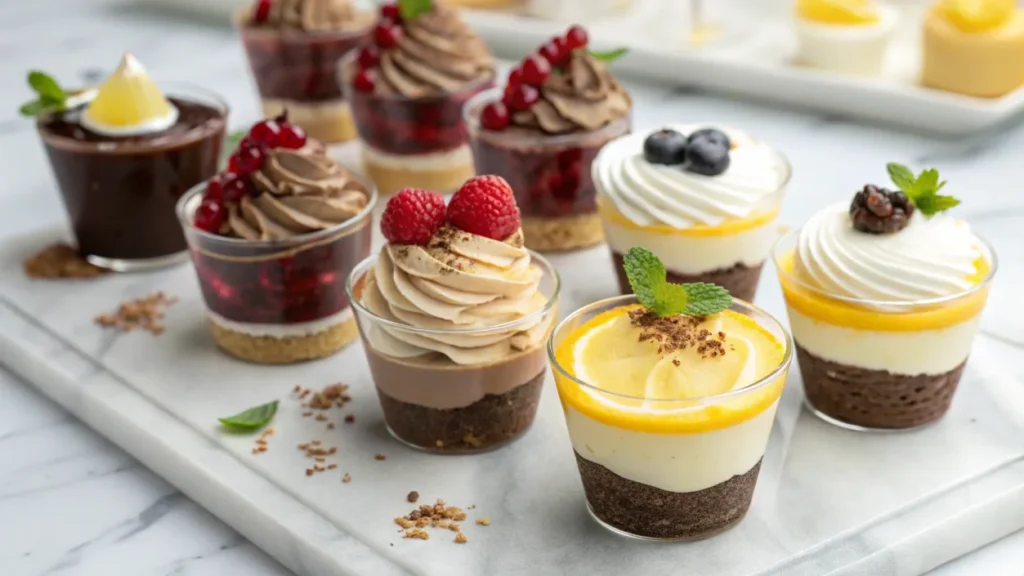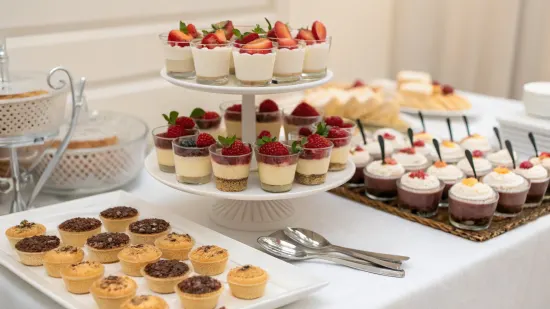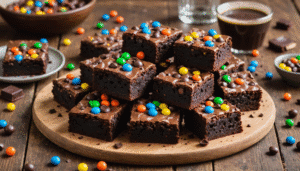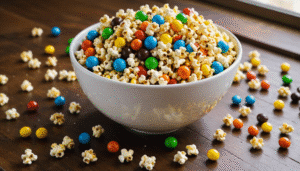Mini Dessert Cups – Why This Recipe?
As Chef Greeny, I’ve always believed that the most memorable desserts come in small packages. My love affair with mini dessert cups began during my culinary training in Paris, where I was captivated by the elegant, portion-controlled desserts served at high-end patisseries. There’s something magical about holding a complete dessert experience in the palm of your hand—layers of flavor and texture that create a perfect bite every time.
What makes these mini dessert cups truly special is their versatility. Whether you’re hosting an elegant dinner party, planning a wedding reception, or simply looking to elevate your family dessert night, these petite treats never fail to delight. I’ve spent years perfecting these recipes, adding my own unique twists to classic concepts.
In this comprehensive guide, you’ll learn how to create seven show-stopping mini dessert cups that balance sophisticated flavors with approachable techniques. I’ll walk you through each component, from the perfect creamy mousse to the crunchiest cookie crumble. By the end of this post, you’ll have everything you need to create desserts that are as beautiful as they are delicious.
Mini Dessert Cups – Ingredients and Preparation
Ingredients List
For Classic Chocolate Mousse Cups:
- 6 oz high-quality dark chocolate (70% cacao)
- 2 tbsp unsalted butter
- 3 large eggs, separated
- ¼ cup granulated sugar
- ½ cup heavy cream
- 1 tsp vanilla extract
- Pinch of salt
- 12 clear plastic or glass mini dessert cups (2-3 oz capacity)
- Chocolate shavings for garnish
Substitutions:
- For dairy-free: Use coconut cream instead of heavy cream and dairy-free chocolate
- For egg-free: Substitute 2 tbsp aquafaba per egg white and silken tofu for egg yolks
For Berry Cheesecake Cups:
- 8 oz cream cheese, softened
- ¼ cup Greek yogurt
- ⅓ cup powdered sugar
- 1 tsp vanilla extract
- ¾ cup fresh mixed berries (strawberries, blueberries, raspberries)
- ¼ cup graham cracker crumbs
- 2 tbsp melted butter
- 1 tbsp honey
- Fresh mint leaves for garnish
Substitutions:
- For gluten-free: Use gluten-free cookie crumbs instead of graham crackers
- For vegan: Use dairy-free cream cheese and coconut yogurt
For Lemon Meringue Cups:
- ¾ cup granulated sugar
- 3 tbsp cornstarch
- ¼ tsp salt
- 1 cup water
- 2 large egg yolks, beaten
- 1 tbsp butter
- ⅓ cup fresh lemon juice
- 1 tbsp lemon zest
- 2 large egg whites
- ¼ cup sugar
- ¼ cup crushed shortbread cookies
- 1 tbsp melted butter
Substitutions:
- For dairy-free: Use coconut oil instead of butter
- For egg-free: Use aquafaba for meringue and cornstarch mixture for filling
Step-by-Step Instructions
Classic Chocolate Mousse Cups:
- Melt chocolate and butter in a heatproof bowl over simmering water, stirring until smooth. Remove from heat and let cool slightly.
- In a separate bowl, beat egg yolks with half the sugar until pale and thick. Gradually fold in the melted chocolate mixture.
- In another clean bowl, whip the egg whites with a pinch of salt until foamy. Gradually add remaining sugar and beat until soft peaks form.
- In a third bowl, whip heavy cream and vanilla until soft peaks form.
- Gently fold the whipped egg whites into the chocolate mixture, followed by the whipped cream, maintaining as much air as possible.
- Transfer the mousse into a piping bag and fill each dessert cup about ¾ full.
- Refrigerate for at least 2 hours or overnight.
- Before serving, garnish with chocolate shavings.
TIP: For a perfectly smooth mousse, ensure all ingredients are at room temperature before beginning, except the cream which should be very cold.
Berry Cheesecake Cups:
- Combine graham cracker crumbs, melted butter, and honey in a small bowl.
- Press about 1 tablespoon of the mixture into the bottom of each dessert cup.
- Beat cream cheese until smooth, then add powdered sugar and vanilla, mixing until well combined.
- Fold in Greek yogurt until just incorporated.
- Transfer the mixture to a piping bag and pipe over the graham cracker layer.
- In a small saucepan, gently warm half the berries with 1 tablespoon of water until they begin to release their juices.
- Cool berry mixture and spoon over the cheesecake layer.
- Top with fresh berries and mint leaves before serving.
TIP: To prevent lumps in your cheesecake filling, make sure the cream cheese is completely softened and beat it thoroughly before adding other ingredients.
Lemon Meringue Cups:
- Combine sugar, cornstarch, and salt in a saucepan.
- Gradually whisk in water and cook over medium heat until mixture thickens.
- Temper the egg yolks by slowly adding some of the hot mixture while whisking constantly.
- Return the entire mixture to the pan and cook for 1 minute more.
- Remove from heat and stir in butter, lemon juice, and zest.
- Mix crushed shortbread cookies with melted butter and press into the bottom of dessert cups.
- Fill cups halfway with the lemon filling and chill until set, about 1 hour.
- Just before serving, beat egg whites until foamy, gradually adding sugar until stiff, glossy peaks form.
- Pipe meringue on top of the lemon filling.
- Use a kitchen torch to lightly brown the meringue, or place under a broiler for 30 seconds.
TIP: When making the lemon curd, whisk constantly to prevent scorching, and strain through a fine mesh sieve for the smoothest texture.
Notes and Tips
Storage:
- Chocolate mousse cups and berry cheesecake cups can be made up to 2 days in advance and stored covered in the refrigerator.
- Lemon meringue cups are best assembled just before serving, though the lemon filling can be made 1 day ahead.
Serving Suggestions:
- Arrange various mini dessert cups on a tiered stand for an impressive dessert buffet.
- Pair with dessert wines: chocolate mousse with port, berry cheesecake with moscato, and lemon meringue with sauternes.
- Serve with tiny dessert spoons for an elevated presentation.
Make-Ahead Instructions:
- Prepare components separately and assemble the day of serving.
- Store creams and mousses in piping bags for easy assembly.
- Cookie bases can be pressed into cups a day ahead and stored covered at room temperature.
Mini Dessert Cups – Nutritional Information
Nutrition Facts (Per Serving of Chocolate Mousse Cup)
- Calories: (~180)
- Carbohydrates: (15g)
- Protein: (3g)
- Total Fat: (12g)
- Saturated Fat: (7g)
- Unsaturated Fat: (4g)
- Trans Fat: (0g)
- Fiber: (1g)
- Sugar: (12g)
- Cholesterol: (85mg)
- Sodium: (45mg)
Nutrition Facts (Per Serving of Berry Cheesecake Cup)
- Calories: (~165)
- Carbohydrates: (14g)
- Protein: (3g)
- Total Fat: (11g)
- Saturated Fat: (6g)
- Unsaturated Fat: (4g)
- Trans Fat: (0g)
- Fiber: (1g)
- Sugar: (10g)
- Cholesterol: (35mg)
- Sodium: (120mg)
Nutrition Facts (Per Serving of Lemon Meringue Cup)
- Calories: (~145)
- Carbohydrates: (24g)
- Protein: (2g)
- Total Fat: (5g)
- Saturated Fat: (3g)
- Unsaturated Fat: (2g)
- Trans Fat: (0g)
- Fiber: (0g)
- Sugar: (18g)
- Cholesterol: (55mg)
- Sodium: (95mg)
Mini Dessert Cups – History and Cultural Significance
The concept of mini dessert cups draws inspiration from various culinary traditions around the world. In French cuisine, they’re reminiscent of “verrines,” layered desserts served in small glasses that became popular in the early 2000s. However, the practice of serving desserts in individual portions dates back much further.
In ancient Rome, small cups of sweetened creams and fruits were served to nobility at the end of lavish feasts. Japanese wagashi and other Asian dessert traditions have long emphasized small, artfully presented sweet bites. The American love affair with mini desserts gained momentum in the early 2010s as part of the “small bites” trend that swept through restaurants and catering services.
What makes mini dessert cups particularly significant in modern culinary culture is their perfect alignment with contemporary dining preferences: portion control, visual appeal for social media sharing, and the ability to offer variety without excess. They represent the democratization of high-end pastry techniques, bringing what was once exclusive to fine dining into home kitchens.
Regional variations abound: In Italy, you’ll find “bicchierini,” featuring layers of tiramisu or panna cotta. In the Middle East, small cups of baklava parfaits blend phyllo, honey, and pistachios. In Latin America, individual cups of tres leches or dulce de leche are popular for celebrations.
Mini Dessert Cups – Creative Variations
Mediterranean-Inspired Olive Oil and Sea Salt Mini Cups
Transform your dessert experience with this sophisticated, less-sweet variation:
- Replace butter with high-quality extra virgin olive oil in the chocolate mousse recipe
- Add a pinch of flaky sea salt to the top
- Include a thin layer of crushed amaretti cookies at the bottom
- Garnish with a small sprig of rosemary
This variation brings a complex, slightly savory element to the dessert table and pairs beautifully with after-dinner coffee or cognac.
Low-Carb Coconut Chia Pudding Cups
For health-conscious guests or those following ketogenic diets:
- Combine 1 can of full-fat coconut milk with 3 tablespoons of chia seeds
- Sweeten with 2 tablespoons of powdered erythritol or monk fruit sweetener
- Add ½ teaspoon vanilla extract and a pinch of cinnamon
- Layer with unsweetened coconut flakes and a few berries
- Top with toasted sliced almonds
This variation is gluten-free, dairy-free, and contains less than 5g net carbs per serving while still providing a satisfying dessert experience.
Tips for Adapting to Dietary Needs:
- For gluten-free versions, replace cookie or graham cracker bases with almond flour-based crusts or gluten-free cookie crumbs
- For dairy-free versions, coconut cream works wonderfully in place of heavy cream, and plant-based cream cheese alternatives can substitute in cheesecake layers
- For sugar-free options, use a blend of erythritol and stevia to maintain proper texture while reducing carbs
- For egg-free recipes, aquafaba (the liquid from canned chickpeas) makes an excellent substitute for egg whites in meringues and mousses
Mini Dessert Cups – Frequently Asked Questions
Can I freeze mini dessert cups?
Most mini dessert cups with creamy components don’t freeze well, as thawing can cause separation and texture changes. However, certain varieties like cheesecake cups can be frozen without the fresh fruit topping for up to 1 month. Wrap each cup individually in plastic wrap, then aluminum foil before freezing. Thaw overnight in the refrigerator and add fresh toppings before serving.
What can I substitute for heavy cream?
Coconut cream makes an excellent substitution for heavy cream in most mini dessert recipes. For a less tropical flavor, cashew cream works well—blend 1 cup of soaked cashews with ½ cup water until completely smooth. In a pinch, you can also use full-fat Greek yogurt, though the tangier flavor will slightly alter the final taste.
How long does it take to prepare mini dessert cups?
Preparation time varies by recipe, but most mini dessert cups require:
- Active preparation: 20-30 minutes
- Chilling/setting time: 2-4 hours or overnight
- Assembly: 10-15 minutes
To save time, prepare components a day ahead and assemble shortly before serving. Most components will keep well in the refrigerator for 2-3 days if properly stored.
How do I prevent my layered desserts from looking messy?
For professional-looking layers:
- Chill each layer until set before adding the next
- Use piping bags with clean, straight cuts for even distribution
- Wipe the inside of the cup clean between layers using a paper towel
- Freeze the cups for 5-10 minutes between layers for extra stability
- Use a small offset spatula to smooth each layer before adding the next
Mini Dessert Cups – Final Thoughts
Mini dessert cups represent the perfect intersection of culinary artistry and practical entertaining. Their individual portions eliminate the need for cutting and serving, allowing your guests to simply grab and enjoy. The versatility of these delightful treats means you can create options for every taste preference and dietary need without multiplying your workload.
What I love most about mini dessert cups is how they transform ordinary ingredients into extraordinary experiences. By focusing on contrasting textures, complementary flavors, and beautiful presentation, even simple components become memorable desserts.
I encourage you to start with the classic recipes shared here and then let your creativity take over. Experiment with seasonal fruits, unexpected spices, or heirloom family recipes reimagined in miniature form. The possibilities are truly endless, and the rewards—both in terms of flavor and the delighted expressions of those you serve—are immeasurable.
Leave a comment below with your favorite flavor combination or a photo of your mini dessert cup creations! I’m always inspired by the creative twists my readers bring to these recipes.
Find out more about the history of miniature desserts on Wikipedia








1 thought on “7 Delightful Mini Dessert Cups That Will Impress Your Guests”